Behind the Data

New enhanced card spending data for Irish households: domestic payment activity and regional distributions
Ciaran Meehan*
September 2023
New enhanced Credit and Debit Card Statistics providing an insight into domestic card spending on a county-by-county basis across Ireland reveals the high proportion of overall card spending undertaken in Dublin, and a growing preference for contactless card payments as a payment method.
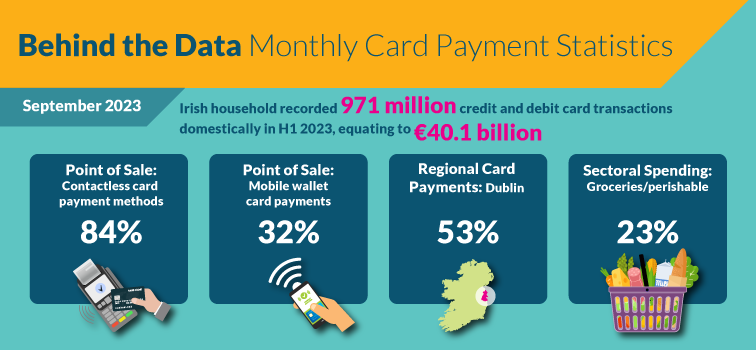
The use of credit and debit cards as a payment method for goods and services is well established. Domestically, over 60 per cent of all non-MFI (i.e. Monetary Financial Institutions) payment transactions relate to credit and debit card transactions. Central Bank of Ireland’s pre-existing Credit and Debit Card Statistics were introduced in 2015 to inform national policy-making and to enhance understanding of the role of credit and debit cards in the domestic financial system. These statistics also provide an insight into consumer spending patterns and therefore support domestic economic analysis. This was particularly true during the Covid-19 pandemic, where the need for timelier and higher frequency data on consumer spending resulted in the introduction of the “Daily Credit and Debit Card Statistics” data collection. Some examples of research and analysis drawing on these data during the Covid-19 pandemic include previous Behind the Data pieces “How has the Covid-19 Pandemic Affected Spending Patterns (Hopkins & Sherman 2020)” and “Shining a light on sectoral spending behaviours through the most recent phases of the pandemic (Hopkins & Sherman 2021)” as well as the Economic Letter “The impact of Covid-19 on consumer spending (Byrne et al 2020)”.
The Central Bank has now undertaken a review of the published Credit and Debit Card Statistics, resulting in an enhanced data collection serving end-user needs and central banking purposes. The review provides more granular insights to understanding spending behaviour, given evolving trends in card payments, increased use of digital financial services by consumers and potential impact of inflation on household spending. This aligns with the future-focused theme under the Central Bank Strategy to expand our range of statistics to meet evolving user needs. New data insights include, a regional breakdown of card spending and contactless / mobile wallet card payments. It had also become more evident that the primary use of the Credit and Debit Card Statistics is to provide a measure of domestic household spending. As a result, the new enhanced monthly data collection will cover card payments by Irish Households only. In addition, the new monthly data collection coincides and more closely aligns methodologically with the recently updated ECB Payment Statistics Regulation. The enhanced ECB Payment Statistics data collection will result in higher frequency and more granular data across all payment instruments (including card payments) than previously available. The launch of the new Monthly Card Payment Statistics will form the first part of a planned broader expansion of published Payment Statistics data expected later in 2023.
Therefore this BTD introduces the enhanced data collection and potential for further analysis by presenting initial insights up to June 2023 and is accompanied by publication of the underlying data tables.
The Data
The enhanced card spending data are collected monthly from issuers of credit and debit cards to Irish residents and specifically from reporting agents that are resident in Ireland. The collection contains the monthly value and volume of transactions across both credit and debit cards.
Also included are a number of new data series and an increased granular breakdown of pre-existing series. New data covers a regional breakdown of card spending across Ireland and data in relation to contactless and mobile wallet card payments. More granular breakdowns include an enhanced breakout of domestic and non-domestic card spending, enhanced breakout of spending where a card is present and also not present, and enhanced breakout of sectoral spending into additional sub-sectors and whether related spending is initiated remotely or non-remotely.
Compared to previously published data, there are a number of methodological changes within the new data collection. Changes include;
- The collected data relates to cards issued to Irish resident households only i.e. business cards that were included in the previous published data are fully excluded from the new data collection.
- No breakout between credit and debit card activity is collected.
- A new “Cash Withdrawals” series is introduced and includes ATM Cash Withdrawals and “Cashback” transactions at Point of Sale (POS) terminals. (Previously, only ATM cash withdrawals were included in the comparative series and related cashback transactions were recorded under card payments.)
- The new data collection also includes some changes in the reporting population that arises following the entry and exit of resident reporting agents in the market.
While the collection offers richer granular card spending breakdowns, these methodological changes do create a statistical break with previously published data affecting time series trends. The new referenced data will be published on a monthly frequency going forward under a rebranded “Monthly Card Payment Statistics” dataset.
Domestic card spending averages €6.8 billion per month during H1 2023
The total value of monthly card transactions (including cash withdrawals) averaged c. €6.8 billion per month during H1 2023, representing an average volume of 162 million card transactions per month. Card payments for goods and services account for the significant majority of total card transactions, with an average value of €5.8 billion per month over the period, accounting for 84 per cent of total card transactions. Cash withdrawals account for the remainder, with an average monthly value of €1.07 billion over the same period (Chart1).
Chart 1: Value of Domestic Card Transactions by Initiation Channel- H1 2023
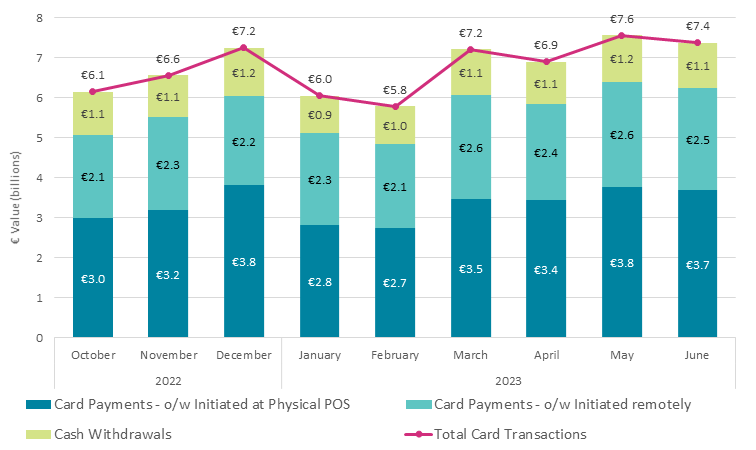
Over three-quarters of all domestic POS card payments in H1 2023 were via contactless card payment methods
New data shows that contactless card payments account for 84 per cent of the total volume of card payments initiated at a physical POS during H1 2023 i.e. excluding online/remote payment transactions (Chart 2). Contactless card payments include transactions that are initiated via a physical plastic card or via mobile wallet at a physical payment terminal. There were an average 103 million contactless card transactions recorded per month over the period, with an equivalent value of €1.7 billion. Total contactless card payments can be further sub-divided into ‘of which initiated via Mobile Wallet’. Mobile wallet payments refer to transactions with cards that are stored on portable devices [e.g. payments initiated via mobile phone/watch card-based wallets such as Apple Pay / Google Pay]. The data shows that mobile wallets are increasingly used as a payment method. During H1 2023, mobile wallet card payments accounted for 32 per cent of all card transactions undertaken at a POS terminal. There were an average 40 million mobile wallet card based payment transactions recorded per month during H1 2023.
Chart 2: Breakdown of Total POS card payments by Initiation Channel (Volume)
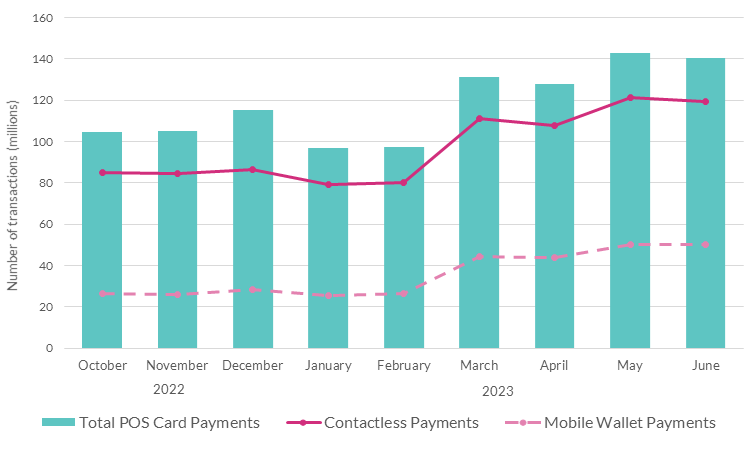
Note: mobile wallet card payments are a subset of total contactless payments
In value terms, contactless and mobile-wallet card payments account for a smaller proportion of overall POS card payment transactions, accounting for 51 and 22 per cent, respectively. This represents the fact that contactless card payments are more generally used for lower value payments.
Over half of all card transactions in H1 2023 occurred in Dublin
New regional data provides a breakout of domestic card transactions across the country. The data shows that 53 per cent of all card payments by value during H1 2023 occurred in Dublin. Card spending in other large cities such as Cork and Galway rank second and third highest, respectively. Using CSO Census population data for 2022, Chart 3 provides a breakdown of card payment transactions per 1,000 population. Dublin remains top of the scale with total card payments equating to €12.6 million per 1,000 population. Total gross card transactions in Dublin amounted to €18.3 billion. On the other hand, Offaly is the lowest ranking county for card spending per 1,000 population.
Domestic cash withdrawals amounted to €6.4 billion in H1 2023. Relative to its share of total card payments, Dublin accounted for a lower overall share of cash withdrawals in the period, accounting for a 33 per cent share of domestic cash withdrawals. Chart 3 shows that cash withdrawals per 1,000 population was higher in Carlow than Dublin during the period. Westmeath was the lowest ranking county for cash withdrawals in the period per 1,000 population.
Chart 3: Domestic Card Transactions by County H1 2023, per 1,000 population
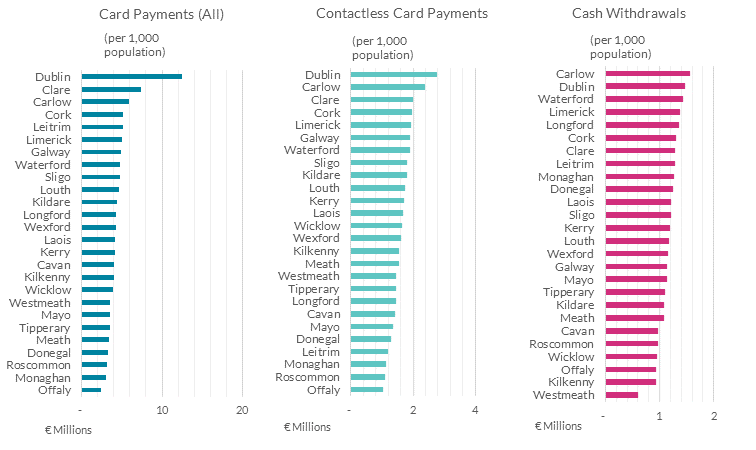
Note: Each Category is ranked in order of the highest to lowest value for respective category. The county location of the transaction is based on the physical terminal location used to process the transaction.
Retail sector card spending accounts for just under half of all card payments
The sectoral and sub-sectoral breakdown of card spending has been enhanced to include new and more granular sub-sectors. New sub-sectors now collected and published for the first time include, Automotive; Consumer Durables; Financial Services; Agricultural Services; Government Services. Looking at the sectoral breakdown of domestic card spending, the data shows that spending in the ‘Retail’ sector accounts for 47 per cent of all domestic spending during the period H1 2023. Within the Retail sector, card spending in the ‘Groceries/Perishables’ sub-sector represented 23 per cent of total domestic card spending, accounting for €1.3bn spent in H1 2023 (Chart 4). Increasing food prices are a likely contributing factor to the high overall share of card spending on ‘Groceries / Perishables’. The CSO Consumer Price Index shows that food prices have increased by 10.1 per cent year-on-year to end-June 2023.
Chart 4: Sectoral Card spending by largest sub-sectors during H1 2023
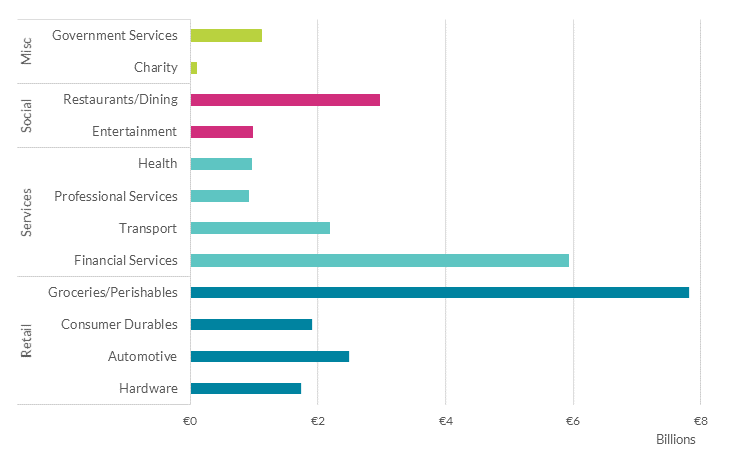
Note: The sector and sub-sector classifications are calculated by the Central Bank from granular level Merchant Category Codes (MCC) reported by reporting agents. A MCC is generally a four-digit number assigned to a business by credit card companies (e.g. MasterCard or Visa) when an entity first begins to accept one of these cards as a form of payment. The MCC is used to classify the business by the type of goods or services it typically provides.
Conclusion
This BTD introduces new and enhanced monthly card payment statistics for Irish households. New data shows that newer payment methods such as contactless card payments and digital mobile wallet card payments account for an increasing share of total card transactions, with contactless card transactions accounting for 84 per cent of all POS card transactions on a volume basis. New regional data on domestic spending by county shows that spending in Dublin accounts for over half of all monthly card payment activity. Card spending on groceries & perishables continues to account for a significant high share of overall monthly card expenditure, representing 23 per cent of all card activity in H1 2023. The new card payment insights outlined in this BTD will be published monthly going forward under the updated “Monthly Card Payment Statistics” dataset.
*Email [email protected] if you have any comments or questions on this note. Comments from Siobhan O’Connell, Maria Woods, Jean Cassidy & Robert Kelly are gratefully acknowledged. Thank you to Valeriya Ustinova for her contribution to earlier draft and excellent data assistance. Thank you to Zita Szanto for her excellent data assistance. The views expressed in this note are those of the authors and do not necessarily reflect the views of the Central Bank of Ireland or the ESCB.
See also: